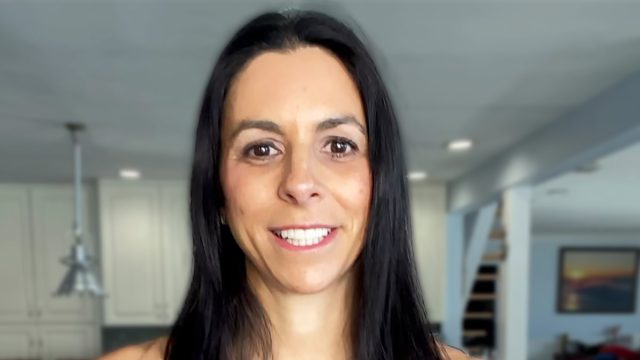She Broke Up with These 5 Bad Habits at 46 and Lost 10 Pounds in 2 Months
Are your unhealthy habits keeping you from achieving your weight loss goals? Heather Eisenberg is a nutrition coach and personal trainer who helps women over 40 "lose weight with nutrition & fitness," she writes in her Instagram bio. In a new social media post, she discusses some of the bad habits she had to give up in order to lose 10 pounds in 2 months at 46. "We all have habits that we want to break…Losing weight in your 40s can feel like a struggle, but small changes can make a big difference!" she writes. "Here are 5 habits I let go of that kickstarted my journey."
Mindless Snacking
The first habit she had to ditch was mindless snacking. "I used to grab snacks throughout the day without even thinking about it—whether I was bored, stressed, or just because the food was there. Now I make sure to have balanced meals that keep me satisfied longer, and when I need a snack, I choose something with protein and fiber, like Greek yogurt or an apple with almond butter," she writes in her post.
Skipping Meals
The next habit she parted ways with was skipping meals. "I used to skip meals, especially breakfast, thinking I was saving calories. But in reality, it would just lead to overeating later in the day," she says. "Now, I make time for regular meals—especially breakfast, which sets the tone for my day. A quick smoothie or some eggs and veggies in the morning helps me feel energized and prevents those late-afternoon cravings."
Processed Foods
The third habit? Relying on processed foods. "Frozen dinners or packaged snacks were a go-to because they were easy. But I realized they were packed with hidden sugars, sodium, and unhealthy fats," she says. "I swapped them out for whole foods—lean proteins, veggies, and healthy carbs. Meal prepping on Sundays was a game changer. It is much easier to avoid the temptation of quick, unhealthy options during the week, and I actually feel more energized after eating real food."
Late Night Eating
Late-night eating was something else she had to ditch. "Eating late at night had become a bad habit. I started closing the kitchen after dinner, giving myself at least 2-3 hours before bed without food. This not only helped me avoid unnecessary calories but also improved my sleep," she writes.
Overthinking Workouts
The fifth habit she had to let go of was overthinking workouts. "I used to think that if I didn't have an hour to hit the gym or couldn't do a perfect workout, it wasn't worth it. Now, I prioritize movement in any form—whether it's a 20-minute walk, or a quick bodyweight workout," she writes.
Breaking Up with Bad Habits Isn't Easy, But the Results Are "Worth It"
While quitting unhealthy habits and replacing them with ones that will help you achieve your goals isn't easy, it pays off in the end, she maintains. "Breaking up with these habits took time, but the results were worth it!"
RELATED: 9 Foods with More Protein Than an Egg for Weight Loss, Says Nutrition Coach
She Also Stopped Cutting Out Entire Food Groups
In another post, she reveals a few more habits she ditched in order to lose weight. The first? Cutting out entire food groups. "Eliminating carbs or fats may seem like the answer, but it's not sustainable. Your body needs a mix of carbs, proteins, and healthy fats to thrive. Cutting out entire food groups can mess with your energy levels, hormones, and mindset. Balance is the key — there's room for everything when you approach food mindfully," she writes.
And, She Stopped Giving Up Foods That She Loves
Another thing she stopped doing? Giving up foods that she loves. "Let's be honest — life without ice cream or pizza sounds miserable! I've learned that allowing myself to enjoy these foods in moderation keeps me sane and on track. Depriving yourself often leads to bingeing or feeling like you've failed. Including foods you love makes healthy eating a lifestyle, not a punishment," she writes.
She Stopped Relying Solely on Cardio
Once she stopped relying solely on cardio, it also changed the game. "I used to think cardio was the best way to lose weight, but resistance training changed everything. Lifting weights builds muscle, boosts your metabolism, and helps you feel stronger and more confident. Cardio has benefits, but strength training reshapes your body in a way cardio alone can't," she writes.
RELATED: Mom Loses 35 Pounds in 6 Months Using 5 Natural Methods to Lower Cortisol
And, She Stopped Letting the Scale Dictate Progress
And, lastly, she stopped letting the scale dictate progress. "The scale is just one number, and it doesn't tell the whole story. Your energy, strength, how your clothes fit, and how you feel are all signs of progress. If you let the scale control your mood, you'll miss out on the real wins. Focus on the bigger picture — it's way more rewarding," she writes. And if you enjoyed this article, take advantage of these 15 Quick Ways to Lose Body Fat Percentage in a Week.





